Rafael Mendoza light machine gun
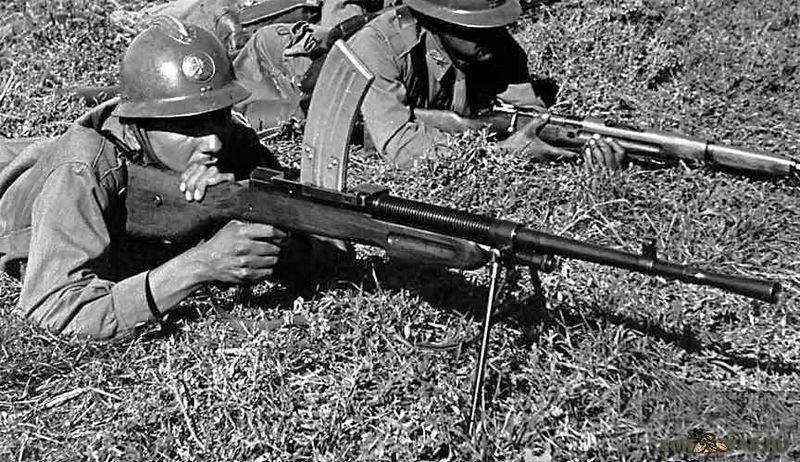
Mexican soldier with Mendoza machine gun in position
"White Chief" Mine Reid
stories about weapons. There are large countries with developed economies, where there are quite a lot of engineers and technicians, as well as weapons designers. And there are countries that are not so very large, whose economy is not too developed, where mainly peasants work, and engineers and gunsmiths are a rarity, like rain. But, nevertheless, breakthroughs sometimes happen in these countries and weapons are created that experts from developed countries can only envy. In this case, we are talking about Mexico, which at the beginning of the twentieth century was not at all the country where people thought about the local development of firearms. And despite this, Mondragon's rifle appeared there. And after the First World War, engineer Rafael Mendoza and his company Productos Mendoza in 1928 began work on their national light machine gun, and it continued until 1933. And crowned with success! It was a weapon intended for use in the Mexican Army as the standard light machine gun at the squad level. At its core, it was supposed to perform the same function as the American M1918 BAR Browning automatic rifle, and supplement the standard infantry squad with more firepower.
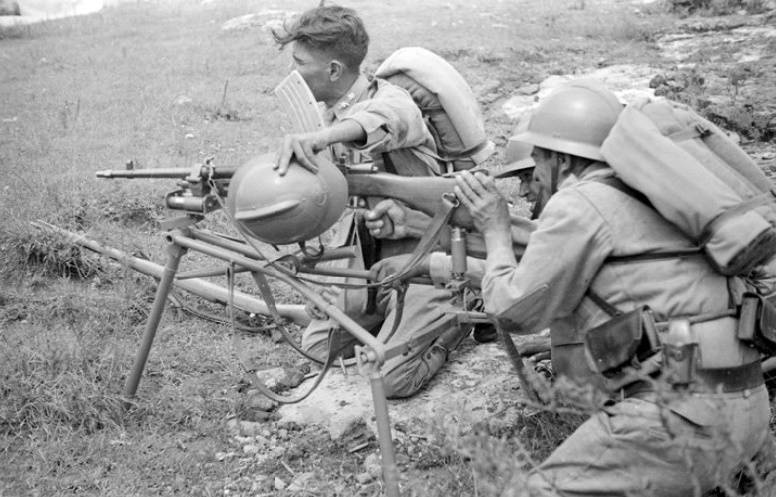
Machine gun "S-1934" on a tripod. Thanks to such a machine gun, this machine gun could shoot much more accurately, fire with dispersion in depth. A similar machine during the Second World War was equipped with German machine guns MG-34 and MG-42
The production of a new machine gun, which received the designation "S-1934" (or "Mendoza Model B" of 1933), was started in the same year in 1933, and in 1934 the machine gun was officially adopted (hence the name). Despite the fact that many parts of this machine gun were in many ways similar to the corresponding parts of the British Lewis machine gun and the French Hotchkiss machine gun, the S-1934 itself was something of a revolutionary design - it turned out to be lighter than its contemporaries, cheaper to manufacture and so efficient and reliable in the field. Like the American BAR submachine gun, the Mexican C-1934 looked like a rifle with a buttstock and solid wood stock without metal inserts. The wooden forearm is equipped with two deep finger grooves.
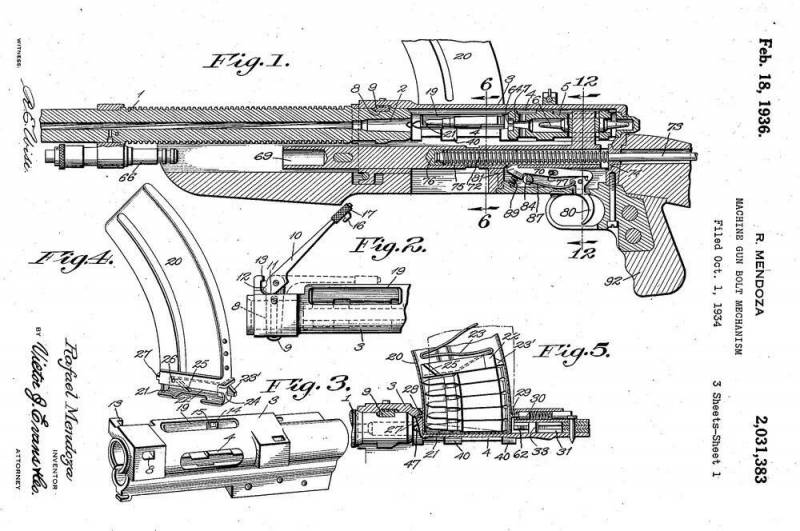
Scheme of the Mendoza machine gun device from the 1936 patent. In the diagram, the bolt is in the rearmost position. The return spring is compressed. Powder gases escaping from the gas pipe under the barrel are vented through the slots between the barrel and the forearm. The barrel mount (Fig. 2) has the form of a lever 10 with a retractable wedge 9, which is included in the groove of the breech breech 8 - a very unusual and original solution. Extraction of spent cartridges to the left, through the oval hole 4 in the receiver (Fig. 4). Pay attention to the location of the return spring - under the bolt, so that it did not overheat when firing!
The pistol grip, also made of wood, with finger cutouts, was located under the rear of the receiver. All parts of the machine gun were in a metal case, which in turn was fixed on the stock and butt. The quick-change barrel, together with a folding bipod, was attached to the receiver at its base, was equipped with a flash suppressor, front sight and namushnik, and an interchangeable sight for anti-aircraft fire.
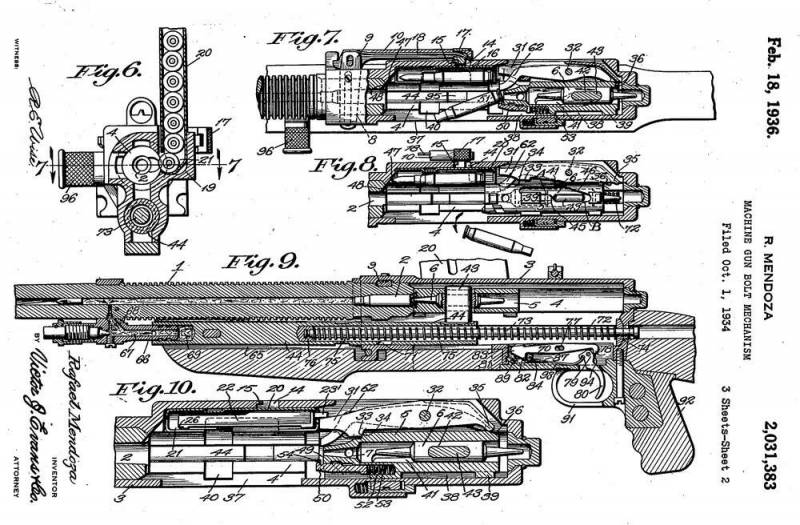
Scheme of the Mendoza machine gun device from the 1936 patent. This diagram (Fig. 6) clearly shows that the sights on the machine gun are not shifted, but the magazine is shifted, which is shifted to the right. The shutter frame device is clearly visible. It has an L-shaped protrusion and a channel inside for the return spring rod and another channel in the front, with which it is put on the gas pipe of the barrel, which, by the way, has a regulator. The frame of the shutter is put on the L-shaped protrusion of the frame in the rear
The machine gun was powered from a 20-round magazine, which was loaded with Spanish Mauser 7x57 cartridges and inserted into the upper part of the receiver. Due to the fastening of the front sight and rear sight along the axis of the barrel, the magazine mount was shifted to the right.
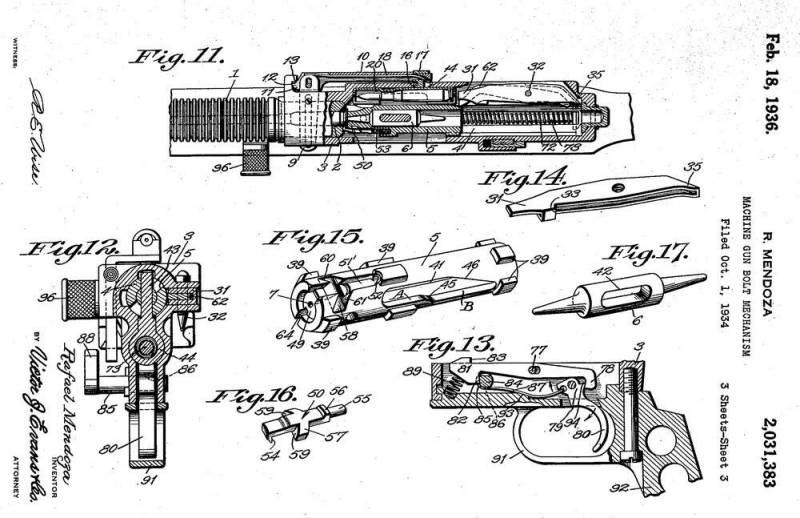
Diagram of the Mendoza machine gun device from the 1936 patent. The most interesting thing on it is the bolt (Fig. 15) with three rows of lugs at once, which provided the machine gun with very reliable locking when fired. The shutter inside the core rotated when the latter moved forward and backward due to the protrusion on it, which moved along the inclined groove. At the same time, the shutter rested against the bottom of the sleeve and captured it with the extractor tooth. Another original detail of the machine gun mechanism is a T-shaped striker (Fig. 17) with two strikers at once: if one breaks, you can turn the part over and continue to fire
The total length of the machine gun was 1170 mm with a barrel length of 630 mm. Automation drive due to the short stroke of the gas piston located under the barrel, on which annular grooves were applied up to the attachment of the bipod for better cooling. Shooting was carried out from an open bolt, as well as in the Lewis machine gun.
This system operated as follows: when fired, powder gases pressed on the bolt carrier, which began to move backward. At the same time, the L-shaped protrusion with the drummer put on it was the first to move. In this case, the frame of the shutter rotated and disengaged with its protrusions with the protrusions on the receiver. The bolt inside it also rotated and removed the spent cartridge case from the chamber. The sleeve was extracted, and the frame continued to move and came to the rearmost position. Now, if the fire selector was in the “automatic” position, the frame would return by spring force. The bolt core was locked, while the striker was the last to finish his movement, which, with his striker, pierced the cartridge primer through the hole in the bolt, causing another shot.
The rate of fire was approximately 450 rounds per minute. Such a relatively low rate of fire allowed better control of the weapon and prevented the barrel from overheating. The muzzle velocity of the bullet was 880 m/s, and the effective firing range was up to 200 meters. The total weight was about 8,4 kg.
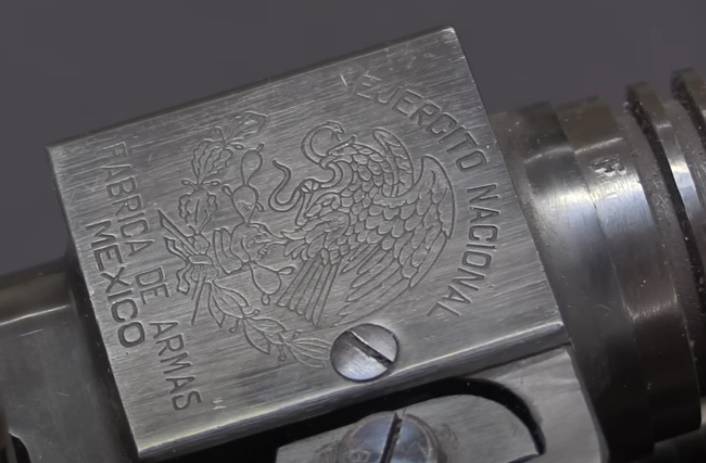
It is enough to look at this emblem: an eagle riding a cactus is tormenting a snake to understand that you have a Mexican weapon in front of you. There is no need to guess! Photo forgottenweapons
"C-1934" had the ability for selective fire, which made it possible to put it on the fuse, conduct single and automatic fire using the selector on the left side of the receiver. The charging handle was also installed on the left side, and even moved far forward.
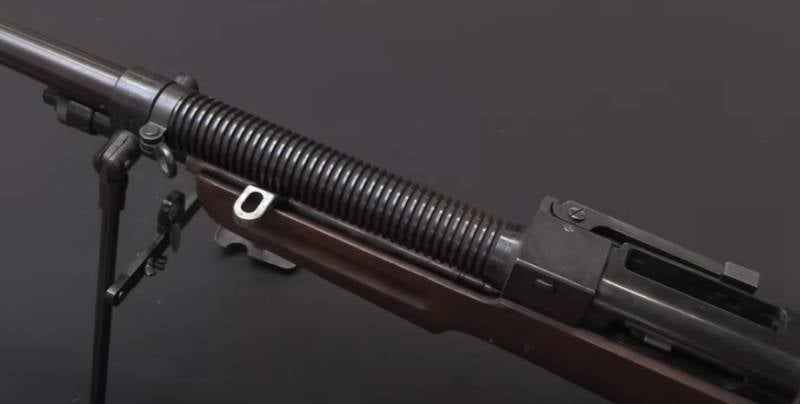
Although the 1936 patent diagram shows the bolt handle as cylindrical, in this photo it has this shape, with an oval slot to reduce weight. Noteworthy are two deep grooves on the forearm for ease of holding. Photo forgottenweapons
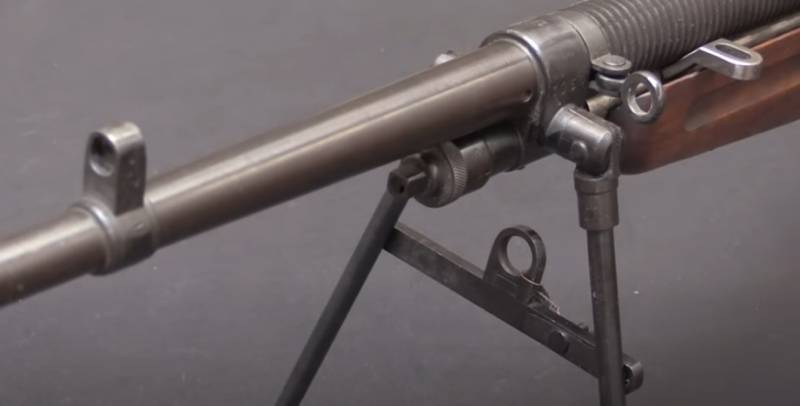
The A-bipod mount on the machine gun barrel was also very strong and reliable. During transportation, it could fold, and in the combat position it was fixed with the help of a crossbar and really looked like the letter A, which gave it greater rigidity than many other machine guns with bipods of that time
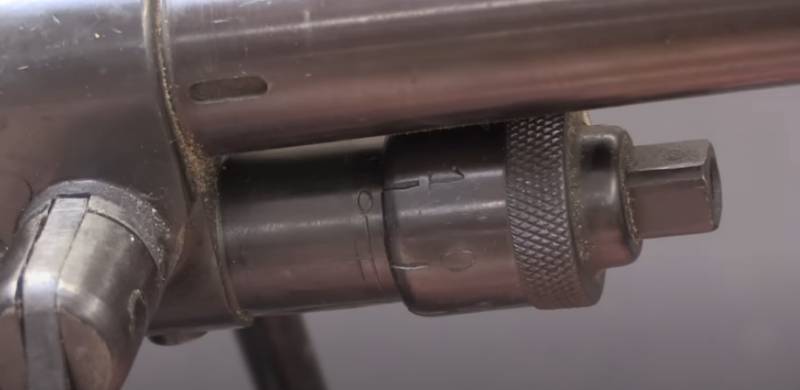
The gas regulator had as many as 8 positions, which made it possible to very accurately adjust the machine gun for firing. Photo forgottenweapons
In practice, the "C-1934" became an inexpensive replacement for the more expensive designs of the time. This budget approach, however, did not interfere with the development of high-quality designs and the creation of completely modern weapons. The infantrymen appreciated the convenience of handling this machine gun and its relatively low weight. In addition, it could be easily disassembled in the field in a relatively short time, which was useful for maintenance and cleaning after use.
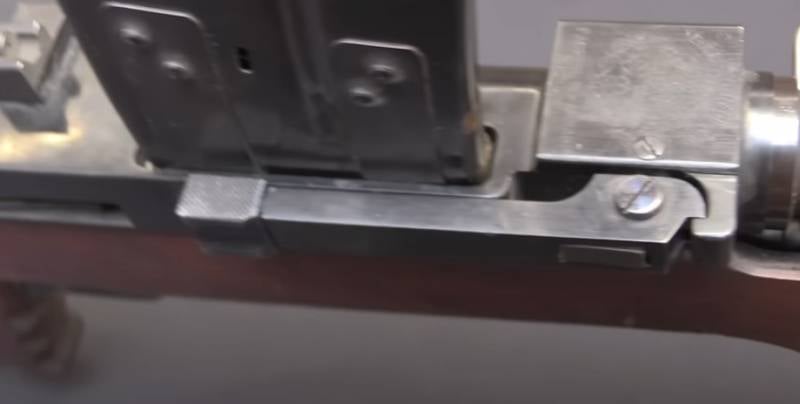
And this is the barrel attachment lever, located on the receiver on the right. To remove the barrel, it had to be folded forward and turned to the right ... Photo forgottenweapons
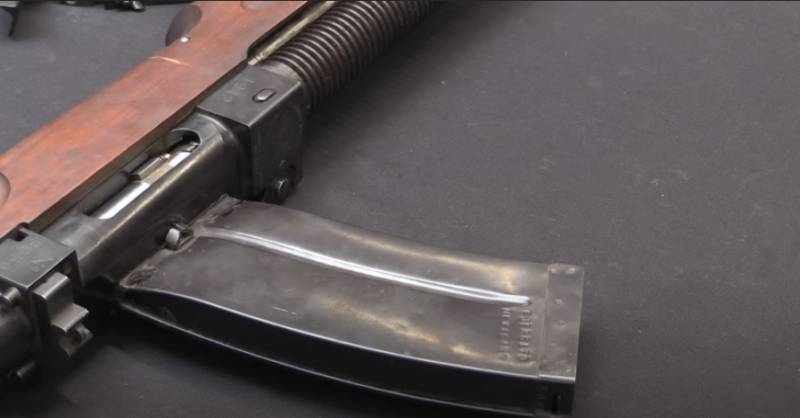
In the diagram from the patent, the store is single-row. But this photo clearly shows that it was two-row, but with a clear narrowing of the neck, with which it was inserted into the receiver, under the supply of one cartridge. Inserting the store, it was necessary to move it forward. At the same time, it was fixed with a special latch and firmly held in place. When removing the store, it was necessary, on the contrary, to file it back and only then pull it out. Photo forgottenweapons
"C-1934" remained in service with the Mexican army until 1945. This year it has been upgraded to replace the outdated Spanish 7x57mm Mauser cartridge with the readily available American 30-06 cartridge (30 caliber M1906). So there was an improved model "Mendoza Model 45" with an improved receiver, a new design of the flash suppressor and a shorter barrel. This machine gun was also designated as "RM-2". However, the RM-2 did not have the expected impact on the market, as the war had already ended and nullified any US ammunition purchases. Mendoza's subsequent attempts to sell it to the Mexican military failed, and Mexico's restrictive export laws prevented it from being sold overseas. It is known that no more than 50 evaluation models were produced in this variant.
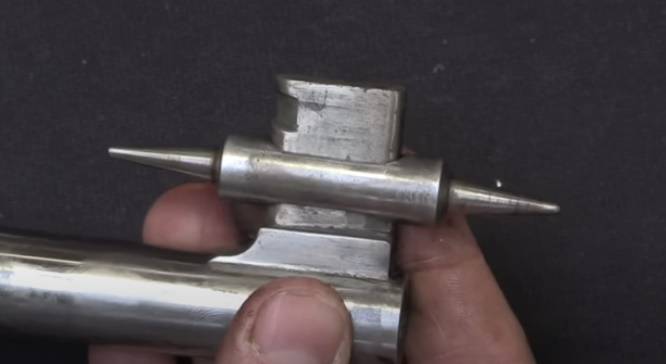
Here is such an unusual drummer with two strikers at once standing on this machine gun. It is hard to imagine that such a metal cone made of hardened steel can break, but if it breaks, then there will be no big trouble. Photo forgottenweapons
Note that the differences were quite significant and concerned not only the use of new cartridges. So, the flame arrester was eight-slotted and at the same time served as a compensator. The buttstock and stock became split. The bolt handle was moved to the right side of the receiver - it acquired a cylindrical shape with a corrugation, but, as before, moved along with the bolt. Another was the arrangement of bipods and their fastening, and the barrel lost its fins. Food was supplied from box magazines, which were still inserted from above, but their shape became different, chambered for American cartridges. The magazine port received a sliding dust cover with a knurled grip. The lever for detaching the barrel from the receiver, as it was on the right, remained. The location of the three-position safety lever has not changed either. The rear sight was an adjustable vertical L-shaped rod attached to the left side of the receiver. The pistol grip remained wooden.
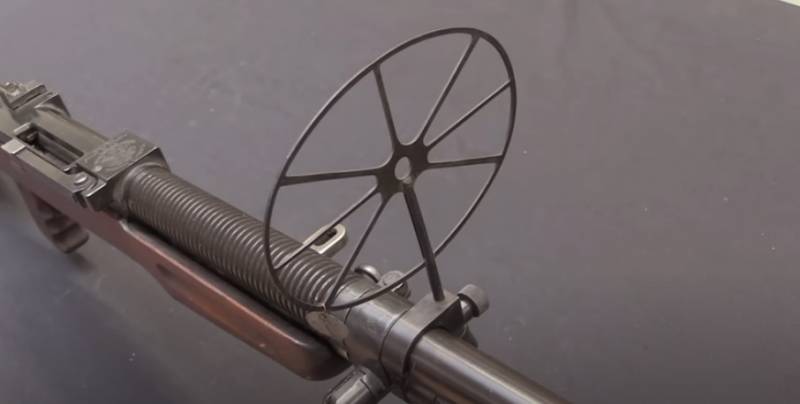
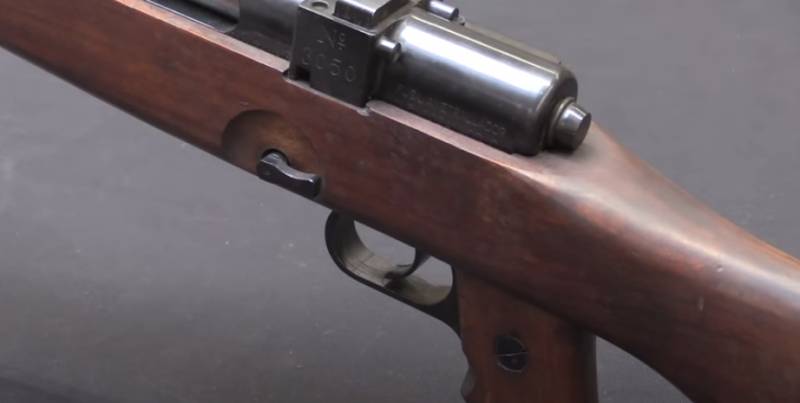
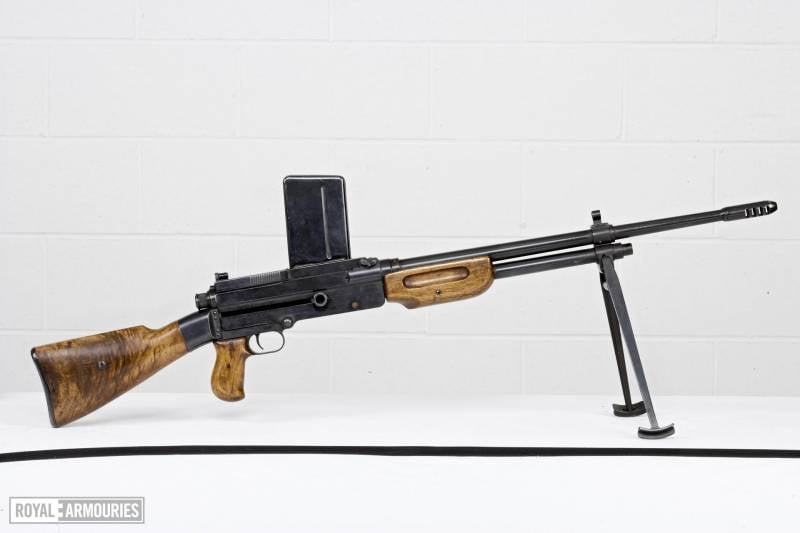
Information